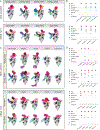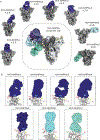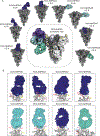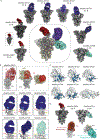Structural serology of polyclonal antibody responses to mRNA-1273 and NVX-CoV2373 COVID-19 vaccines
- PMID: 40632654
- PMCID: PMC12486969
- DOI: 10.1016/j.celrep.2025.115986
Structural serology of polyclonal antibody responses to mRNA-1273 and NVX-CoV2373 COVID-19 vaccines
Abstract
Design and development of improved COVID-19 vaccines that can induce broad, durable immunity against emerging variants require an in-depth understanding of the antigenic and immunogenic properties of vaccines utilizing existing platforms. Here, we examine the antigenicity of two original COVID-19 vaccines by performing secondary analyses of the clinical trials for mRNA-1273 (this study was registered at ClinicalTrials.gov NCT04283461) and NVX-CoV2373 (this study was registered at ClinicalTrials.gov NCT04368988) using electron microscopy-based polyclonal epitope mapping (EMPEM). Both vaccines induce diverse polyclonal antibody (pAb) responses to the N-terminal domain (NTD) in addition to the receptor-binding domain of the Spike protein, with the NTD supersite being an immunodominant epitope. High-resolution cryo-EMPEM studies reveal extensive pAb responses to and around the supersite, with unique angles of approach and engagement. NTD supersite pAbs are also the most susceptible to variant mutations compared to other specificities, indicating that ongoing Spike ectodomain-based vaccine design strategies should consider immuno-masking this site to prevent induction of these strain-specific responses.
Keywords: COVID-19 vaccines; CP: Immunology; CP: Microbiology; EMPEM; NTD supersite; NVX-CoV2373; SARS-CoV-2; Spike; antibody response; mRNA-1273; polyclonal antibodies.
Copyright © 2025 The Author(s). Published by Elsevier Inc. All rights reserved.
Conflict of interest statement
Declaration of interests K.S.C.-H., B.S.G., and A.B.W. are inventors on US Patent No. 10/960,070 B2, entitled “Prefusion Coronavirus Spike Proteins and Their Use.” K.S.C.-H. and B.S.G. are inventors on US Patent Application No. 202117798021, entitled “SARS-CoV-2 Vaccine.” A.B.W. is an inventor on US Patent No. 11217328, entitled “Epitope Mapping Method.” B.G., R.D. and D.K.E. are employees of Moderna, Inc. and may hold stock/stock options in the company. A.R., M.G.-X., N.P., and G.S. are employees of Novavax, Inc. and hold stock or stock options.
Figures







Update of
-
Structural serology of polyclonal antibody responses to mRNA-1273 and NVX-CoV2373 COVID-19 vaccines.bioRxiv [Preprint]. 2024 Dec 12:2024.12.11.628030. doi: 10.1101/2024.12.11.628030. bioRxiv. 2024. Update in: Cell Rep. 2025 Jul 22;44(7):115986. doi: 10.1016/j.celrep.2025.115986. PMID: 39713412 Free PMC article. Updated. Preprint.
References
-
- Lau JJ, Cheng SMS, Leung K, Lee CK, Hachim A, Tsang LCH, Yam KWH, Chaothai S, Kwan KKH, Chai ZYH, et al. (2023). Real-world COVID-19 vaccine effectiveness against the Omicron BA.2 variant in a SARS-CoV-2 infection-naive population. Nat. Med. 29, 348–357. 10.1038/s41591-023-02219-5. - DOI - PMC - PubMed
Publication types
MeSH terms
Substances
Associated data
Grants and funding
LinkOut - more resources
Full Text Sources
Medical
Miscellaneous

